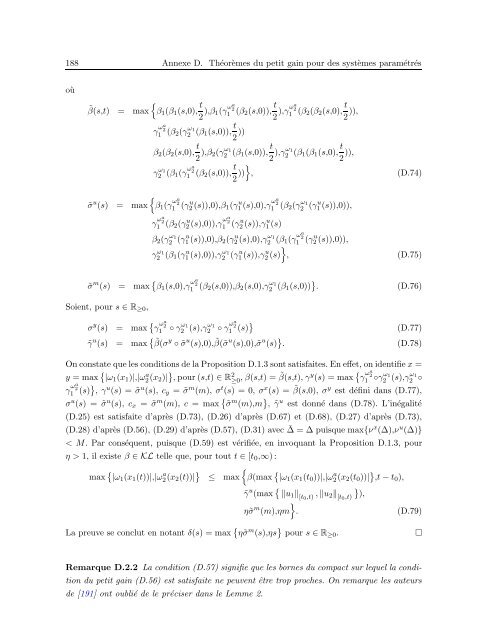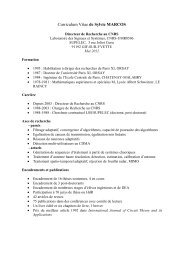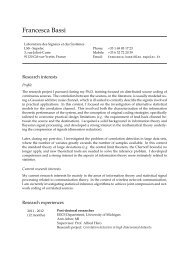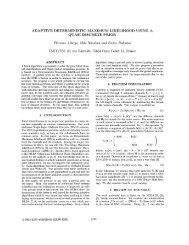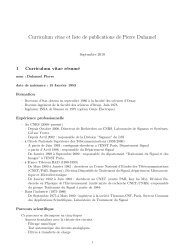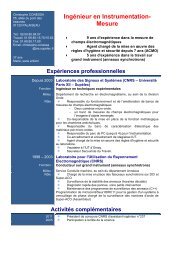THÈSE DE DOCTORAT Ecole Doctorale « Sciences et ...
THÈSE DE DOCTORAT Ecole Doctorale « Sciences et ...
THÈSE DE DOCTORAT Ecole Doctorale « Sciences et ...
You also want an ePaper? Increase the reach of your titles
YUMPU automatically turns print PDFs into web optimized ePapers that Google loves.
188 Annexe D. Théorèmes du p<strong>et</strong>it gain pour des systèmes paramétrés<br />
où<br />
{<br />
˜β(s,t) = max β 1 (β 1 (s,0), t 2 ),β 1(γ ωa 2<br />
1 (β 2(s,0)), t 2 ),γωa 2<br />
1 (β 2(β 2 (s,0), t 2 )),<br />
γ ωa 2<br />
1 (β 2(γ ω 1<br />
2 (β 1(s,0)), t 2 ))<br />
β 2 (β 2 (s,0), t 2 ),β 2(γ ω 1<br />
2 (β 1(s,0)), t 2 ),γω 1<br />
2 (β 1(β 1 (s,0), t 2 )),<br />
γ ω 1<br />
2 (β 1(γ ωa 2<br />
1 (β 2(s,0)), t 2 )) }, (D.74)<br />
{<br />
˜σ u (s) = max β 1 (γ ωa 2<br />
1 (γu 2 (s)),0),β 1(γ1 u (s),0),γωa 2<br />
1 (β 2(γ ω 1<br />
2 (γu 1 (s)),0)),<br />
γ ωa 2<br />
1 (β 2(γ u 2 (s),0)),γωa 2<br />
1 (γu 2 (s)),γu 1 (s)<br />
β 2 (γ ω 1<br />
2 (γu 1 (s)),0),β 2 (γ u 2 (s),0),γ ω 1<br />
2 (β 1(γ ωa 2<br />
1 (γu 2 (s)),0)),<br />
γ ω 1<br />
2 (β 1(γ u 1 (s),0)),γω 1<br />
2 (γu 1 (s)),γu 2 (s) }, (D.75)<br />
˜σ m (s) = max { β 1 (s,0),γ ωa 2<br />
1 (β 2(s,0)),β 2 (s,0),γ ω 1<br />
2 (β 1(s,0)) } . (D.76)<br />
Soient, pour s ∈ R ≥0 ,<br />
σ y (s) = max { γ ωa 2<br />
1 ◦ γ ω 1<br />
2 (s),γω 1<br />
2 ◦ γ ωa 2<br />
1 (s)} (D.77)<br />
˜γ u (s) = max { ˜β(σ y ◦ ˜σ u (s),0), ˜β(˜σ u (s),0),˜σ u (s) } . (D.78)<br />
On constate que les conditions de la Proposition D.1.3 sont satisfaites. En eff<strong>et</strong>, on identifie x =<br />
y = max { |ω 1 (x 1 )|,|ω a 2 (x 2)| } , pour (s,t) ∈ R 2 ≥0 , β(s,t) = ˜β(s,t), γ y (s) = max { γ ωa 2<br />
1 ◦γω 1<br />
2 (s),γω 1<br />
2 ◦<br />
γ ωa 2<br />
1 (s)} , γ u (s) = ˜σ u (s), c y = ˜σ m (m), σ t (s) = 0, σ x (s) = ˜β(s,0), σ y est défini dans (D.77),<br />
σ u (s) = ˜σ u (s), c x = ˜σ m (m), c = max {˜σ m (m),m } , ˜γ u est donné dans (D.78). L’inégalité<br />
(D.25) est satisfaite d’après (D.73), (D.26) d’après (D.67) <strong>et</strong> (D.68), (D.27) d’après (D.73),<br />
(D.28) d’après (D.56), (D.29) d’après (D.57), (D.31) avec ¯∆ = ∆ puisque max{ν x (∆),ν u (∆)}<br />
< M. Par conséquent, puisque (D.59) est vérifiée, en invoquant la Proposition D.1.3, pour<br />
η > 1, il existe β ∈ KL telle que, pour tout t ∈ [t 0 ,∞) :<br />
max { |ω 1 (x 1 (t))|,|ω2 a (x 2(t))| } {<br />
≤ max β(max { |ω 1 (x 1 (t 0 ))|,|ω2 a (x 2(t 0 ))| } ,t − t 0 ),<br />
˜γ u (max { ‖u 1 ‖ [t0 ,t) , ‖u }<br />
2‖ [t0 ,t) ),<br />
}<br />
η˜σ m (m),ηm . (D.79)<br />
La preuve se conclut en notant δ(s) = max { η˜σ m (s),ηs } pour s ∈ R ≥0 .<br />
□<br />
Remarque D.2.2 La condition (D.57) signifie que les bornes du compact sur lequel la condition<br />
du p<strong>et</strong>it gain (D.56) est satisfaite ne peuvent être trop proches. On remarque les auteurs<br />
de [191] ont oublié de le préciser dans le Lemme 2.


